Database of luminescent minerals
ARAGONITE
Chemical formula: CaCO3
Family: Carbonates
Status: IMA-GP
Crystal system : Orthorhombic
Display mineral: OUI
Associated names (luminescent varieties, discredited names, synonyms, etc.): flos ferri, nicholsonite, strontio-aragonite, mossottite, tarnowitzite, ammolite, septaria, perle, ktypéite, Erzbergite,
Luminescence:
Longwave UV (365nm) colors: |
Yellowish White , White , Bluish White , Pinkish White , Orange , Orange Red , Red , Violet red , Violet Pink , Pink , Salmon pink , Blue , Greenish white , | ||
Intensity LW:Strong | Frequency LW:Very often | ||
Midwave UV (320nm) colors: |
Pink , White , Bluish White , Yellowish White , Pinkish White , Pale Yellow , Orange Red , Red , Violet red , Violet Pink , Salmon pink , Greenish white , Yellowish , | ||
Shortwave UV (254nm) colors: |
Bluish White , White , Bluish White , Yellowish White , Pinkish White , Pale Yellow , Orange , Orange Red , Red , Violet red , Violet Pink , Pink , Salmon pink , Yellowish Green , Green , Greenish white , Yellowish , | ||
Intensity SW:Medium | Frequency SW:Very often | ||
Longwave (365nm) picture
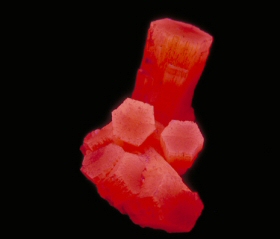
ARAGONITE, Sicily, Italy.
OL (365 nm)
Col. G.Barmarin; Photo: G. Barmarin
Shortwave (254nm) picture
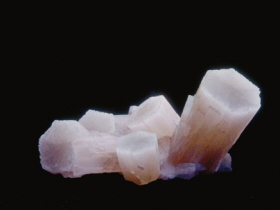
ARAGONITE, Sicily, Italy.
OC (254 nm)
Col. G.Barmarin; Photo: G. Barmarin
Pictures Galery:


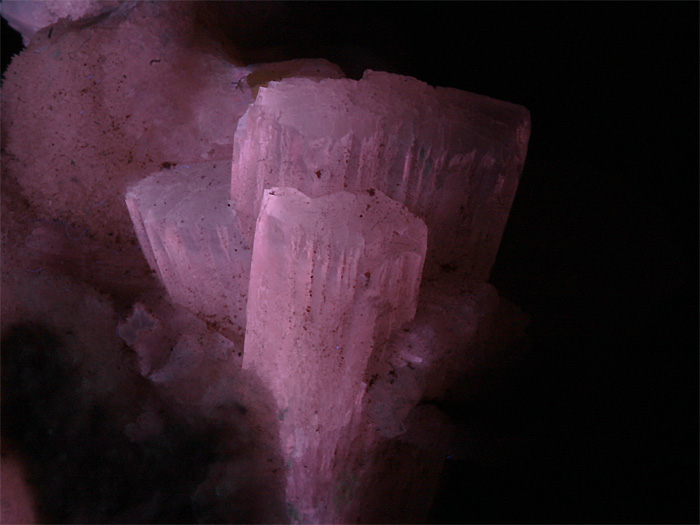
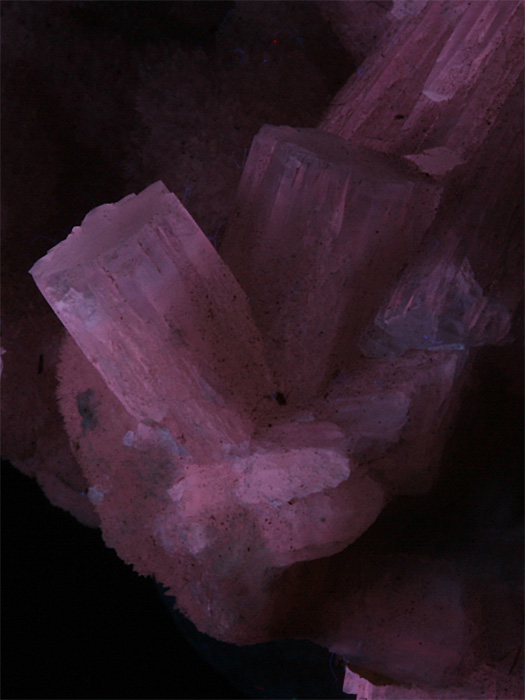 ...
...  Go to the galery (16 pictures)
Go to the galery (16 pictures)
Do you have a photo of this mineral you would like to see in the gallery? Contact us!
Phosphorescence (in the common sense of the term) observable with the naked eye:
Type d'UV |
Couleur |
Intensité |
Fréquence d'observation |
|---|---|---|---|
UV longs (365nm): | Greenish white | Strong | Often | UV moyens (320 nm): | Greenish white | Strong | Often | UV courts (254 nm): | Greenish white | Strong | Often |
Thermoluminescence: OUI
Comments:
Kunz and Baskerville noted that aragonite fluoresces often strongly during their memorable investigation of 13000 mineral specimens in 1903.
Activator(s) and spectrum:
Activator(s): Mn2+ , (UO2)2+ (ion Uranyle) en impureté, ST (Singlet-triplet)-Matière organique en impureté, Ce3+, Sm3+, Eu3+, Dy3+, Centres dûs aux effets des radiations,
Peaks in the spectrum (nm):
Sm3+ repl. Ca2+ : 603, 640nm Mn2+ : broad band at 630nm (120nm half-width) Dy3+ : 482, 486, 578, 579nm Radiation induced center : 580nm (very short decay time of approximately 20 ns)

Spectrum: Michael Gaft, Petah Tikva, Israel. Plot: Institute of Mineralogy, University of Vienna, Austria, with permission of the authors.
Spectrum Galery:
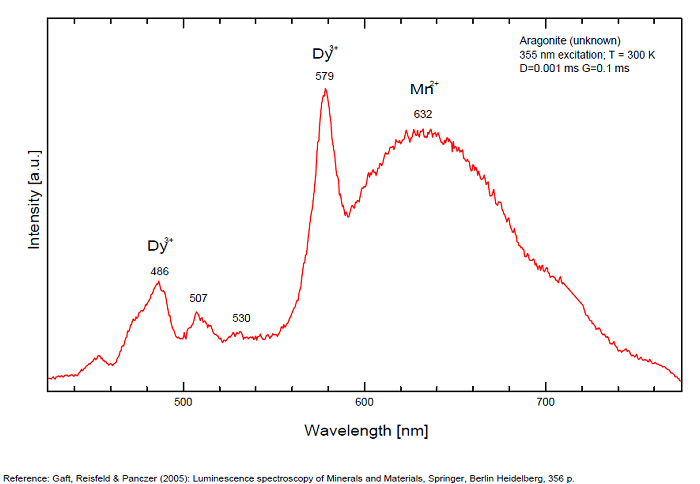

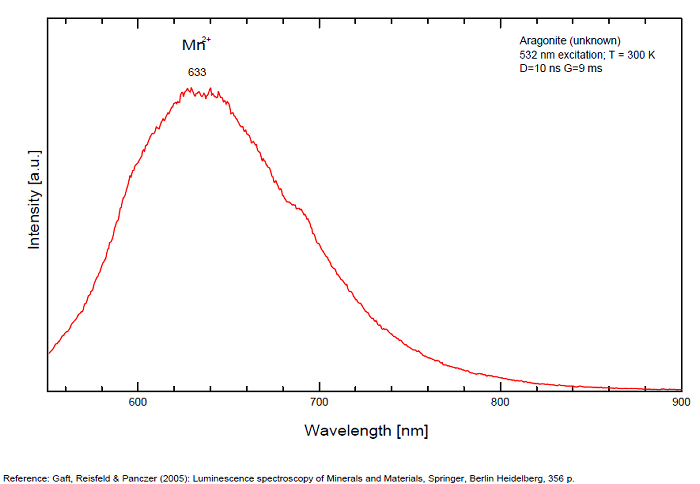
 ...
...Comments on spectrum and activators:
Fluo green: due to U in traces; Under cw laser excitation at 532 and 780nm several bands and narrow lines have been found in visible and IR parts of the spectrum. Evidently they may be connected with another type of Mn2+, trivalent REE, such as Sm3+, Eu3+ and different types of Nd3+ centers. The origin of the broad band peaking at approximately 700 nm needs further study. The frequent occurrence of slight amounts of Strontium in aragonite was known during the time of Becquerel and he ascribed the luminescence to the presence of strontium. Later, Nichols confirmed the idea. Hence the name strontioaragonite for some specimen of very bright red fluorescing aragonite. Actually, strontium is not considered anymore as the activator responsable for the red fluorescence of aragonite and Mn and REE are considered as the principal activators of this red fluorescence.
Activators: Mn2+, Sm3+, Dy3+ (Gaft)
The broad luminescence band peaking at 580 nm with very short decay time of approximately 20 ns, could by analogy with Terlingua-type calcite may be preliminarily ascribed to radiation induced luminescence center. (Gaft)
Best localities for fluorescence (*):
- Strontio-aragonite: red SW and LW, Boccheggiano mines, Montieri, Grosseto Province, Tuscany, Italy;
- Aragonite fluo pink/salmon LW, white SW : Sulphur Mine near Agrigento, Agrigento Province, Sicily, Italy;
- Giumentaro Mine (Capodarso Mine), Capodarso, Enna (Castrogiovanni), Enna Province, Sicily, Italy;
- Cozzo Disi Mine, Casteltermini, Agrigento Province, Sicily, Italy;
- Nicholsonite: fluo and phospho white SW & cream LW, Zinc Mine Friedenville, Friedensville, Saucon Valley, Upper Saucon Township, Lehigh Co., Pennsylvania, USA
- Tarnowitzite:yellowish-white, strongest SW or red SW: Tsumeb Mine, Tsumeb, Otjikoto Region, Namibia;
- Tarnowitzite: Touissit, Touissit District, Jerada Province, Oriental Region, Morocco ( Straw-yellow fluorescence SW+LW);
- Aragon de Molina, Spain (Twinned xls agregated in balls);
- Tazouta, Sefrou, Sefrou Province, Fès-Boulemane Region, Morocco (Twinned xls agregated in balls, dull green SW);
- Chihuahua, Mexico (bright green SW);
- Gallo river, Molina de Aragón, Guadalajara, Castile-La Mancha, Spain (dull white SW);
- Pantoja, Toledo, Castile-La Mancha, Spain (Acicular Aragonite bright blue-white LW);
- Great Southern Mine, Red Picacho District, Wickenburg area, Yavapai Co., Arizona, USA;
- Copper Canyon, Camp Verde, Camp Verde District, Yavapai Co., Arizona, USA (aragonite pseudomorph after glauberite, cream-yellow LW, MW & SW);
- Bisbee, Warren District, Mule Mts, Cochise Co., Arizona, USA (Patches of bright green fluorescence under SW & patches of bright creamy white fluo LW);
- Long Lake Zinc Mine, Olden Township, Frontenac Co., Ontario, Canada (fluo blue SW in red fluo calcite);
(*)The data are not exhaustive and are limited to a few remarkable localities for fluorescence
Bibliographic reference for luminescence:
- The Henkel Glossary of Fluorescent Minerals, Dr. Gerhard Henkel, Published by the FMS, 1989 ,
- Fluorescence: Gems and Minerals Under Ultraviolet Light, Manuel Robbins, 1994, Geoscience Press, ISBN 0-945005-13-X ,
- The World of Fluorescent Minerals, Stuart Schneider, Schiffer Publishing, 2006, ISBN 0-7643-2544-2 ,
- Luminescence Spectroscopy of Minerals and Materials, M. Gaft, R. Reisfeld, G. Panczer, Springer Editor, ISBN: 10 3-540-21918-8 ,
- Luminescent Spectra of Minerals, Boris S. Gorobets and Alexandre A. Rogojine, Moscow, 2002 ,
- Handbook of Fluorescent Gems and Minerals, a practical guide for the gem and mineral collector, Jack de Ment, 1949 ,
Reference for luminescence on the Internet:
- MONT-SAINT-HILAIRE, History, Geology, Mineralogy, Laszlo HORVATH, The Canadian Mineralogist, Special Publication 14, 2019
Images:
- Pantoja, Toledo, Spain (Acicular Aragonite bright blue-white LW): http://www.mindat.org/photo-100547.html
- Great Southern Mine, Arizona, USA (with calcite & fluorite): http://www.mindat.org/photo-67554.html
- Great Southern Mine, Arizona, USA (with calcite & fluorite, details): http://www.mindat.org/photo-67557.html
- Agrigento, Agrigento Province, Sicily, Italy: http://www.mindat.org/photo-415916.html
- Giumentaro Mine, Enna Province, Sicily, Italy: https://www.mindat.org/photo-504841.html
- Bisbee, Arizona, USA: http://www.mindat.org/photo-505652.html
- Long Lake Zinc Mine, Ontario, Canada:
- Nicholsonite: Zinc Mine Friedenville, Pennsylvania, USA (SW): http://www.mindat.org/photo-573241.html
- Nicholsonite: Zinc Mine Friedenville, Pennsylvania, USA (LW): http://www.mindat.org/photo-573242.html
- Nicholsonite: Zinc Mine Friedenville, Pennsylvania, USA (SW): http://www.mindat.org/photo-573244.html
- Nicholsonite: Zinc Mine Friedenville, Pennsylvania, USA (LW): http://www.mindat.org/photo-573245.html
Mineralogical reference on the Internet:
 http://www.mindat.org/show.php?name=Aragonite
http://www.mindat.org/show.php?name=Aragonite
 http://webmineral.com/data/Aragonite.shtml
http://webmineral.com/data/Aragonite.shtml
Internet Search:
 Image search on 'Google Images'
Image search on 'Google Images'
 Search for documents in all languages on Google
Search for documents in all languages on Google
A request providing no result means only that no such reference exists in the database, but it does not mean that what you are looking for does not exist, just not to our knowledge. If you think you have found an error or omission, please let us know via the contact page being sure to cite the source of information.
